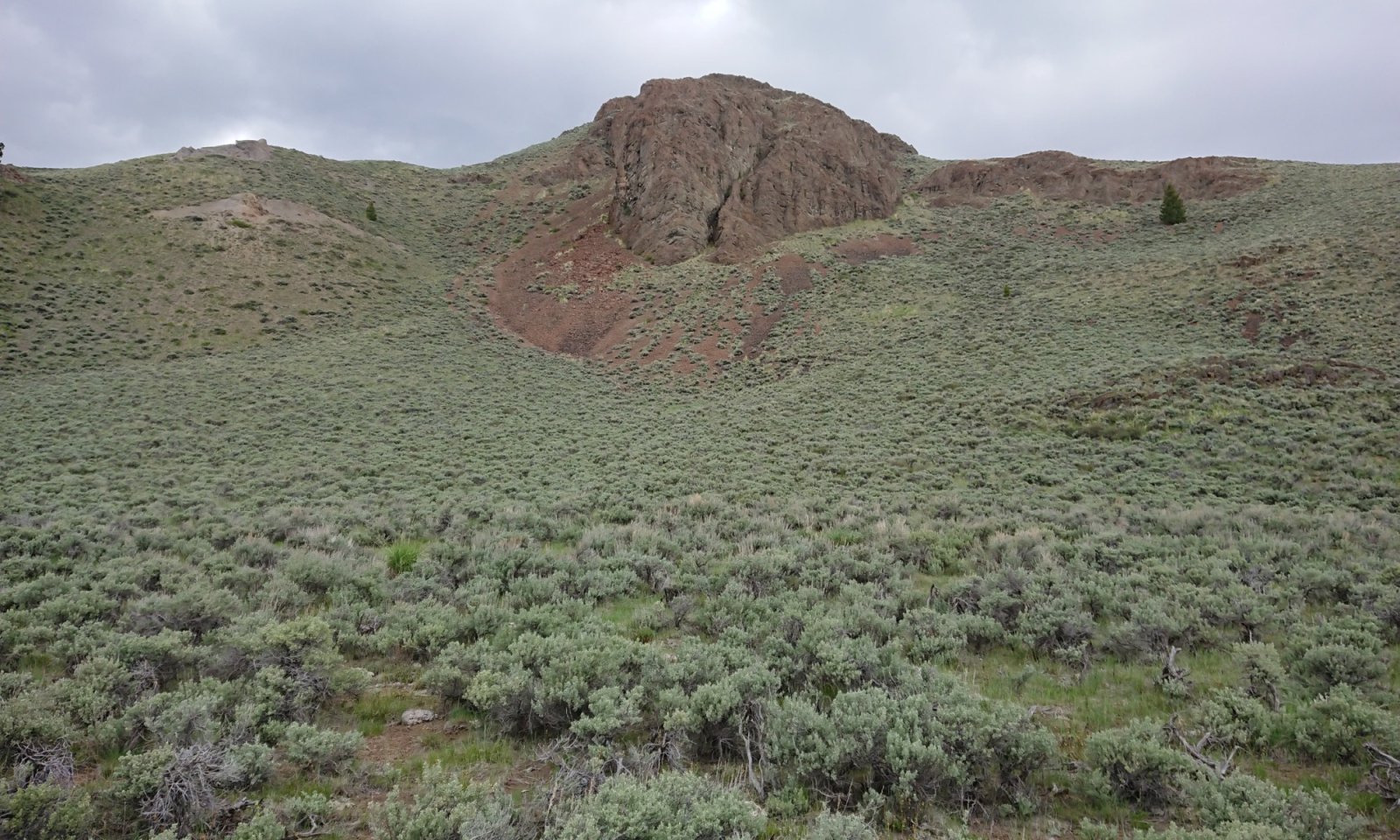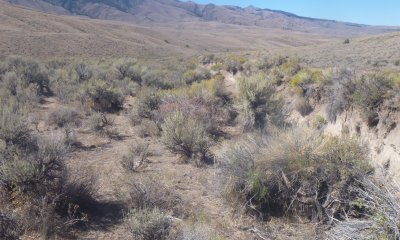
Loamy 15 to 19 Inch Precipitation Zone Lost River Mountains
Scenario model
Current ecosystem state
Select a state
Management practices/drivers
Select a transition or restoration pathway
- Transition T1-2 More details
- Restoration pathway R2-1 More details
-
No transition or restoration pathway between the selected states has been described
Target ecosystem state
Select a state
Description
The Reference State of the Loamy 15 to 19 inch ecological site consists of three dominant plant communities. Community 1.1 and 1.2 are dominated by a mountain big sagebrush (Artemisia tridentata spp. vasayana) overstory. Community 1.1 has a dominant understory of Idaho fescue (Festuca idahoensis) and the understory of community 1.2 is dominated by bluebunch wheatgrass (Pseudoroegneria spicata). Community 1.1 is more predominant closer to the higher end of the effective precipitation range (15 to 19 inches) as Idaho fescue is better adapted to slightly wetter conditions (Zouhar, 2000). Community 1.3 occurs more often in valley or drainage bottoms where sandy loam soil textures are more prevalent. The community is comprised of a basin big sagebrush dominated overstory with a mixed perennial grass understory. The characteristics of the Loamy 15 to 19-inch ecological site allow for high productivity and diversity in the overstory and understory relative to other ecological sites within the Lost River Mountain LRU.
Processes (natural and anthropogenic) that can result in state and community changes include frequent or severe fire occurrence, grazing that results in chronic defoliation, and land use changes (Davies et al., 2011).
Characteristics and indicators
The shift between communities at this ecological site is primarily driven by slight variations in local abiotic conditions. Shift in the understory composition from Idaho fescue to bluebunch wheatgrass is usually attributed to available moisture. Although Idaho fescue can be present closer to the 15-inch end of the effective precipitation range, bluebunch wheatgrass is better adapted to these conditions and tends to occupy a greater percentage of the canopy (Zouhar, 2000).
Shift from an overstory canopy dominated by mountain big sagebrush to basin big sagebrush can be attributed to changes in soil texture and landform. Basin big sagebrush tends to dominate when soil texture conditions shift to sandy or silty loams and/or landforms that include floodplains, low stream terraces, and drainages (Tirmenstein, 1999).
Resilience management
This site has moderate to high resilience as a result of the cryic soil temperature regime and xeric soil moisture regime. Resistance and resilience of a specific site have been attributed to abiotic conditions favorable to plant growth and reproduction (Maestas et al. 2016). Soils that fall within the cryic (cold) temperature regime and xeric (wet) moisture regime tend to have higher diversity and production and are therefore more resilient, specifically in terms of resisting or recovering from invasion post-disturbance (Maestas et al., 2016).
On the LRU scale, this site may also have increased resistance to post-disturbance invasion due to the biodiversity generally present at the site. Sites with high biodiversity have been shown to exhibit increased resistance and resilience as a result of the differential impact of disturbances such as insect, disease, and fire on the variety of species present (Oliver et al., 2015).
Submodel
Description
The Disturbed state is a result of both natural and anthropogenic disturbance events that result in widespread sagebrush mortality at a given site. The primary natural disturbance resulting in sagebrush mortality at this ecological site is severe or frequent wildfire; however, intense freeze events and insect and disease can also occur. Both mountain big sagebrush and basin big sagebrush are particularly susceptible to stand-replacing fires and often experiences complete canopy loss during moderate and severe wildfire events (Innes, 2017 & Tirmenstein, 1999).
Because this LRU exists primarily on publicly managed lands (US Forest Service, Bureau of Land Management, and State), widespread anthropogenic disturbance events are infrequent. Examples of anthropogenic disturbance events include brush management through sagebrush mowing or removal treatments, chemical treatments, or improper grazing techniques that result in high-intensity hoof disturbance or chronic defoliation.
A combination of natural and anthropogenic disturbance is possible and can result in increased severity of disturbance, decreased resilience, and greater difficulty returning to the Reference State. For example, intense grazing that results in significant defoliation post-fire disturbance can increase bare ground cover, increase erosion potential, and slow the reestablishment of native grass species that preclude the return of overstory sagebrush canopy (Zlatnik, 1999).
Characteristics and indicators
The primary indicator of the Disturbed State is a near-complete loss of overstory sagebrush species, often replaced by shrub species that are able to take advantage of the local disturbance regime. Common replacement species include Artemisia tripartita (threetip sagebrush) and Chrysothamnus viscidiflorus (yellow rabbitbrush). A shift towards an increase in native and disturbance-tolerant grasses and forbs is likely with the removal of resource competition associated with the sagebrush overstory presence. Severe disturbance events also increase the opportunity for invasion of annual grasses and weeds such as cheatgrass (Bromus tectorum) and thistle species. The canopy cover percentage of these species is usually dependent on the distance of a seed source post-disturbance, but mostly stays under five percent (Zlatnik, 1999).
Resilience management
Resilience in this state is moderate. Many of the post-disturbance grasses and shrubs that are common in this state establish quickly and reach a representative canopy within 10 years post-disturbance. Grasses and shrubs continue to increase until the overstory canopy of sagebrush begins to return. However, local resilience in this state is highly dependent on current soil moisture availability, seed sources, timing and severity of the disturbance. In the instance of fire disturbance, bluebunch wheatgrass mortality can be significantly lower if the fire occurs in the spring as opposed to fall. Recovery can be impacted by the quantity of immediate post-fire precipitation (Zlatnik, 1999).
More severe disturbances increase possibility of post-disturbance invasion. The greater the establishment of invasives, the lower the site resilience becomes.
Submodel
Mechanism
Transition from the Reference to the Disturbed State is a mechanism of moderate to severe disturbance, both natural and anthropogenic. The most likely disturbance to cause this transition is wildfire. Other disturbances include but are not limited to freeze kill events, insect and disease, overgrazing, and mechanical brush removal.
Constraints to recovery
The primary constraint to recovery is the distance to a seed source and time. When the disturbance is severe and the extent is great, seed source populations for sagebrush species may be removed from the vicinity. In this case, immigration and re-establishment of overstory sagebrush species can be slow. Re-establishment to pre-disturbance canopy cover and extent of mountain big sagebrush cover generally exceeds 25 years even in ideal conditions (Innes, 2017). This time period can be greatly reduced through seeding and planting interventions.
Context dependence
The primary factors driving the likelihood of restoration success are post-disturbance weather patterns and the distance from viable seed sources. Disturbances that cover a larger extent increase distance to seed sources. Prolonged periods of drought can slow restoration processes. Alternately, average to above-average precipitation post-disturbance can greatly increase speed and success in the re-establishment of sagebrush species (Robin, 2017; Steinberg, 2002; and Fryer, 2009).
Mechanism
The most important mechanism driving restoration from the disturbed state to the reference is time without sagebrush removing disturbance. Distance from overstory species (sagebrush) seed source can also impact the speed of restoration. Seeding or planting of desired overstory species found in the Reference state can speed restoration efforts.
Context dependence
Restoration is highly dependent on time without disturbance. New sagebrush seedlings are moderately sensitive to disturbances such as flood, freeze, and insect and disease. They are highly sensitive to herbivory and even low-severity fire events (Fryer, 2009 & Steinberg 2002).
Seeding and planting of desired species can speed up the restoration process, however; regeneration success with or without planting is highly dependent on localized weather patterns during the restoration period. Periods of drought will slow the process significantly, whereas periods of above-normal precipitation aid in sagebrush regeneration and establishment (Innes, 2017; Steinberg 2002 & Fryer, 2009).
Model keys
Briefcase
Add ecological sites and Major Land Resource Areas to your briefcase by clicking on the briefcase (![]() ) icon wherever it occurs. Drag and drop items to reorder. Cookies are used to store briefcase items between browsing sessions. Because of this, the number of items that can be added to your briefcase is limited, and briefcase items added on one device and browser cannot be accessed from another device or browser. Users who do not wish to place cookies on their devices should not use the briefcase tool. Briefcase cookies serve no other purpose than described here and are deleted whenever browsing history is cleared.
) icon wherever it occurs. Drag and drop items to reorder. Cookies are used to store briefcase items between browsing sessions. Because of this, the number of items that can be added to your briefcase is limited, and briefcase items added on one device and browser cannot be accessed from another device or browser. Users who do not wish to place cookies on their devices should not use the briefcase tool. Briefcase cookies serve no other purpose than described here and are deleted whenever browsing history is cleared.
Ecological sites
Major Land Resource Areas
The Ecosystem Dynamics Interpretive Tool is an information system framework developed by the USDA-ARS Jornada Experimental Range, USDA Natural Resources Conservation Service, and New Mexico State University.


